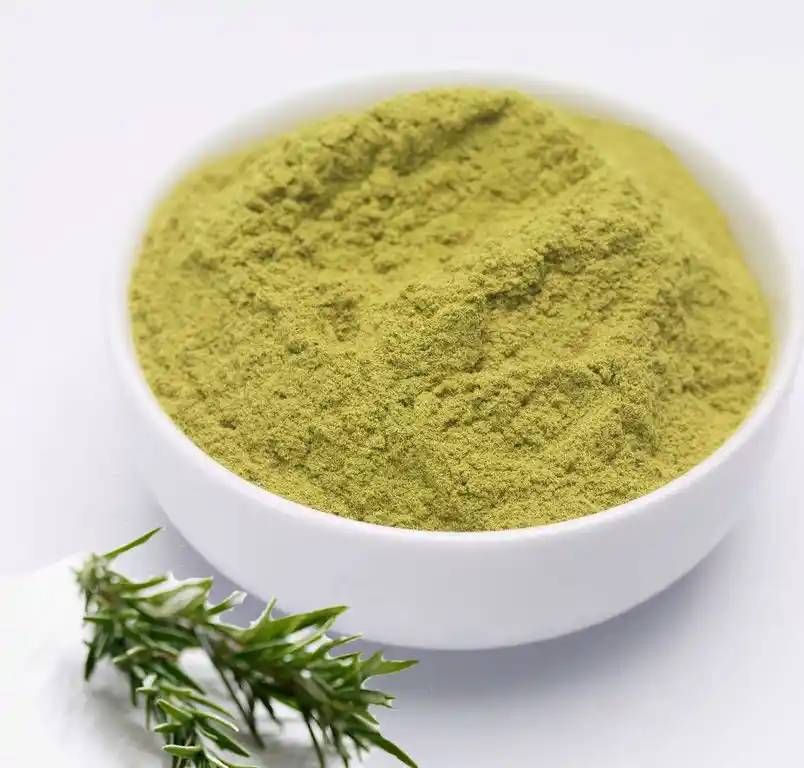ローズマリー抽出物の原料と動物飼料への使用は何ですか?
要旨:ローズマリーは天然の香辛料植物であり、テルペノイド、フラボノイド、有機酸が豊富で、抗感染性、抗炎症性、抗酸化作用があり、動物の性能と製品の品質を向上させることができます。本稿では,家畜及び家禽の生産におけるローズマリーの主要な活性物質,抽出プロセス,生理機能及び関連研究を概観し,動物生産におけるローズマリーの更なる発展と利用を支援することを目的とする。
Rosemary(Rosmarinus officinalis L.), family Labiatae, genus Diego, also known as the dew of the sea. Rosemary is a small aromatic evergreen shrub with medicinal and food properties, 1 ~ 2 m tall, with clustered linear leaves and small light blue or mauve flowers. The leaves and flowers secrete volatile oils that produce a special strong aroma (Sai, Chunmei and Liang, 2012). Rosemary originated from the Mediterranean coast and was widely cultivated in southern Europe. It was introduced into China during the Cao Wei period and is now cultivated mainly in the southern region and Shandong, with rapid development of rosemary cultivation in Henan in recent years.
ローズマリーは暖かい気候と長い日差しが好きで、寒い冬の気候はその成長に適していません。良いローズマリーはスパイス、自然化粧品の和食コース料理で広く使われているローズマリーウェルビーイングブームと豊かなポリフェノールフラボノイドや有机酸、多種多様既に証明な気がする生物の活動静菌など抗酸化、消炎anti-tumor活動により、可能性がある薬として開発される(呉・孟・と徐2016年Xiao-jun)。ローズマリーの有効成分は飼料添加物としても開発され、近年注目されている。ローズマリー資源の開発と利用のためには、ローズマリーの活性成分と生理機能の包括的かつ深い理解が重要です。そこで、本稿では、家畜・家禽の生産におけるローズマリーの主な活性物質、抽出過程、生理機能、および関連研究を概観し、動物生産のためのローズマリー活性物質の開発のための参考資料を提供することを目的とする。
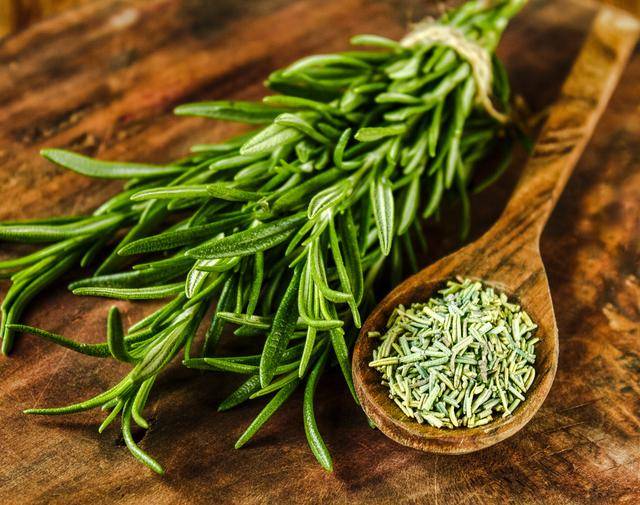
1ローズマリーエキスの有効成分
ローズマリーの主な活性成分の2种类に分けられる一つは揮発性物質monoterpenesとsesquiterpenesが多く主な成分で精油、ローズマリー、ともう一つは不揮発性化された部品で主にpolyterpenesフラボノイドと有機酸、として開発して多い天然抗酸化剤(2019 Sheng-Nan柳ら)。
1.1ウェルビーイングブームと相まって
ローズマリーのテルペノイドには、モノテルペン、セスキテルペン、ジテルペン、トリテルペンがあり、これらはローズマリーの中で最も豊富で複雑な成分である。
1.1.1モノテルペンとセスキテルペン
Monoterpenesとsesquiterpenesは各主要な階級のローズマリーのアロマオイルを見つけ成分の1を含む8-eudesmanein、α-pinene、樟脳・camphene、β-pinene、geranylgeranyl、veratryl ketone(2015年Tadtongら)。ローズマリーには16のサブクラスがあり、多くの栽培株があります。主要成分の相対的な量の違いから、ローズマリーの精油は化学的に分類することができ、現在13種類以上の化学的タイプのローズマリー精油があります(satyal et al., 2017)。ローズマリー精油の成分は、採取地域や採取時間、抽出方法や場所、保存方法などの影響を受けます。北京のローズマリー精油の抽出率は4.04%で、貴州(2.71%)より高かった。ローズマリーの精油抽出率は、夏に収穫したものが3.13%、冬に収穫したものが2.35%と高かった。原発全体の抽出、精油ローズマリーを使用することができるとα精油成分にとして-pinene叶や茎とlobeline(2015年Lemosら;pan yan et al., 2013)。
1.1.2 Diterpenes
ローズマリーに含まれるジテルペノイドは、熱的に安定で蒸留中に分解されず、主にジテルペンフェノールとジテルペンキノンの高い熱的安定性を有しています。ジテルペンフェノールはローズマリーの中の主な抗酸化成分で、主にセージフェノール、セージ酸、ロスマリノール、ローズマリーの乾燥葉の含有量はそれぞれ4.21%、0.39%、0.12%です(zheng and wang、2001;okamura et al., 1994)。ローズマリー中のジテルペンキノンは主にロスマリキオンやロイレノンなどである(he liwei et al., 2020)。
1.1.3 Triterpenoids
ローズマリー中のトリテルペノイドは、主にトリテルペノイド、ウルソル酸、ベツリノール、オレアノル酸、ベツリン酸である(hanson, 2016)。
120フラボノイド
There are more than 40 types of flavonoids in the herb, with a content of about 0.16%, which are also the main antioxidant substances in rosemary. Flavonoids include thujaplicins, naringin, やケルセチン, lignans, etc. (Ren Liping et al., 2017).
1.3有機酸
ローズマリーの有機酸は抽出物の約5.55%を占め、主にローズマリー酸、コーヒー酸、p-クマル酸である(peng et al., 2005)。その中でも、ロスマリン酸はローズマリーの重要な活性物質と考えられており、ポリフェノール水酸基を含み、抗酸化、抗菌、抗炎症作用があることが示されています(wang yan, 2013)。ロスマリン酸は植物から抽出されるだけでなく、生物学的、酵素的、化学的に合成される(geng, lijun and zhao, 2018)。
1.4他の成分
ローズマリーはまた、糖、配糖体、アルキル酸、アミノ酸およびzn、fe、cu、mnおよび他の成分を含んでいます。
2成分抽出ローズマリーの成分
2.1ローズマリー精油の抽出方法
ローズマリー精油は、主にモノテルペン、セスキテルペンなどの強い揮発性成分を含み、有機溶剤抽出、蒸留、超臨界流体抽出などの方法で抽出することができます。有機溶媒抽出法で抽出される精油は、収率が高く安定性に優れているが、有機溶媒が残留しやすく、不純物の除去が困難で、コストが高く、時間が長く、工業化されていない。精油を用いた水蒸気蒸留抽出法は、水に溶けにくく、水の特性と反応しないため、精油成分と水蒸気が同時に蒸発する。エッセンシャルオイルの蒸気蒸留抽出は、シンプルで実用的な、低投資、より多くの実際の生産ですが、蒸留時間が長く、高温であるので、エッセンシャルオイル成分の分解。超臨界流体抽出法は、エッセンシャルオイルの高収率、良好な品質を得て、活性および熱的に不安定な成分を十分に保護することができますが、投資は大きく、設備のメンテナンスコストが高く、プロセス要件が高い(zhao xueliら、2020)。抽出効率を向上させるために、酵素法と超音波法が一般的にローズマリー精油の抽出を支援するために使用されています(zhang lin et al., 2016)。
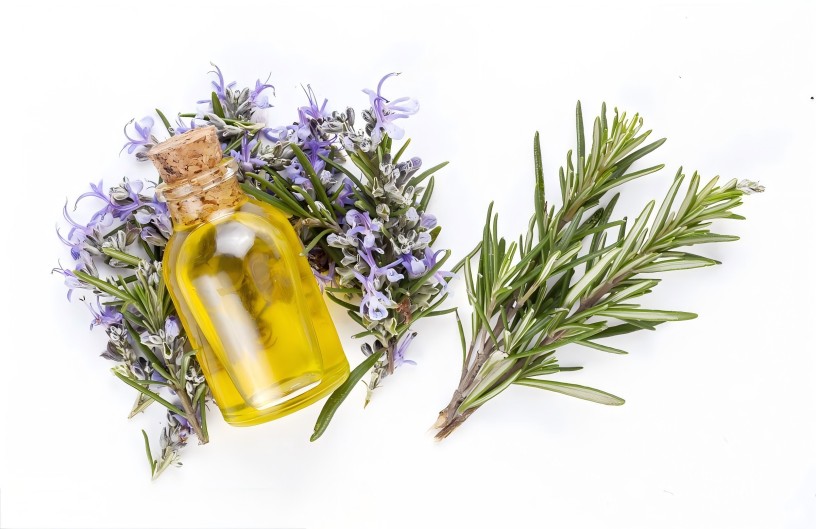
2.2ローズマリーからの抗酸化物質の抽出
ローズマリーのもう一つの重要な用途は、主にサルビノリン、サリチル酸、ロスマリノール、ロスマリン酸などを含むローズマリーの葉からの抗酸化物質の抽出です。現在、ローズマリーから抗酸化物質を抽出する主な方法は、溶媒抽出と超臨界流体抽出である。現在、ローズマリーから抗酸化成分を抽出する主な方法は、溶媒抽出と超臨界流体抽出である。超臨界流体抽出(sfe)は、溶媒残渣がなく、製品の品質が高いため、製薬会社や食品会社で使用されています(rosemary cole et al., 2006)。
3ローズマリーエキスの有効成分の生物学的用途
3.1 Anti-infective
多くの植物は細菌を抑制するために二次代謝物を産生しており、これは病原体の侵入に対する適応反応である可能性がある。今日、ローズマリーは食品保存料として広く使用されていますその強力な抗菌活性を利用している(wang et al., 2012)。抗菌の活動のよりも高い精油ローズマリー化合物1が独身8-eudesmusとα-pinene、可能性もあり、間にの相乗効果での抗菌エッセンシャルオイルです。中にある化合物はローズマリー精油は抗菌作用に加えて、殺虫作用、抗寄生虫作用、抗真菌作用がある(swamy et al., 2016;luqman et al., 2007)。in vitroの抗菌試験では、表皮ブドウ球菌、黄色ブドウ球菌、枯草菌などのグラム陽性菌、ミラビリスプロテウス、緑膿菌pseudomonas、大腸菌などのグラム陰性菌、カンジダ・アルビカンスおよびaspergillus nigerの2つの菌株に対して良好な静菌活性が示された。ローズマリン酸は細菌の細胞膜の透過性を高め、細胞内の栄養素の排出を引き起こし、細胞の代謝に影響を与え、静菌効果を発揮する(jiang et al., 2011)。
3.2消炎
炎症は異物に対する身体の適応反応であるが、過度の慢性炎症は有害である。ローズマリーは呼吸器系の炎症の治療によく使われる気管支喘息など(zanella et al., 2012)。Rosemarinus製造(ロス)おやすみ(RD) phenols一酸化窒素が(NO)循環したかαを減らす-tumor壊死因子(α-TNF)生産リポ多糖類(のLPS) -activatedマクロファージを通じて抑制一酸化窒素シンターゼ(iNOS)とcyclooxygenase-2(剤)。また、抑制されるlipopolysaccharide-induced核要因の核転地κB p65 (NF -κB)を阻害のリン酸化・堕落ことによって僕はBκネズミ講RAW264.7でαをれるマクロファージ・コロニーセルライン。単純なシリマリニン酸とシリビノールの抗炎症作用は、ローズマリー抽出物よりも弱く、ローズマリーのフェノール酸成分が抗炎症作用に相乗効果を持つ可能性がある(kuo et al., 2011)。
3.3抗酸化
Compared with synthetic antioxidants, plant-derived antioxidants have the advantages of being non-toxic and free of side effects, and can be used in the storage of meat, fats and oils, as well as in the prevention and treatment of oxidative damage-related diseases such as cancer, cardiovascular diseases, and neurodegeneration. In vitro antioxidant tests have shown that sage acid, sage phenol, rosemarinic acid, rosemarinol, oleanolic acid and ursolic acid have scavenging activity against 1,1-diphenyl-2-picrylhydrazyl (DPPH) radicals (Beretta et al., 2011). Sageol, rosmarinol and epi-rosmarinol also prevent lipid peroxidation by scavenging lipid free radicals (Zeng et al., 2001). Addition of sage and rosemary essential oils to mouse diets reduced oxidative stress, decreased lipid peroxidation levels in the heart and brain, and increased tissue glutathione peroxidase, catalase, and superoxide dismutase activities (Rakovi et al., 2014). Shen Tingting et al. (2014) found that rosemary extract could enhance the expression of antioxidant enzymes by regulating the key antioxidant component nuclear factor-related factor-2 (Nrf-2).
3.4他
いくつかの研究で、ジフェンバキアには抗がん、肝保護、神経内分泌調節活性があることが示されている(kompelly et al., 2019)。
4動物飼料におけるローズマリー抽出物の応用
4.1家禽類
0.5%のローズマリー葉ミールを食事に添加することで、毎日の体重増加とabbottle &の飼料と肉の比率が改善されました#39;s broilers, increased plasma levels of total protein, albumin, and globulin, while decreasing glucose, total lipids, and cholesterol, and increased the lymphoid organ index and anti-sheep erythrocyte antibody levels. However, addition of more than 0.5% decreased growth performance and digestibility of most nutrients (Ghazalah and Ali, 2008). Yesilbag et al. (2011) found that the addition of rosemary oil (100, 150 mg/kg and 200 mg/kg) and rosemary leaf powder (equivalent to the above mentioned essential oils) to diets tended to improve the performance of Ross-308 broilers by decreasing malondialdehyde and E. coli levels in the meat, lowering the pH of the meat and improving the flavor. Mathlouthi et al. (2011) demonstrated that the addition of 100 mg/kg of essential oil of Dieppe to the diet significantly improved the daily weight gain and feed conversion efficiency of Abbott' s農場の鶏。静海黄鶏の食事に150と200 mg/kgのローズマリー精油を添加すると、性能と肉の質が改善され(li aihua、2014)、抗酸化能力(liu dalinら、2014)、およびthymus指数(liu yannanら、2016)。tangら(2018)は、精製されたローズマリーエキス(>95%ラムノサス酸)が心筋損傷を改善し、熱ショックタンパク質cryabとhsp70の高発現を誘導し、熱ストレスを受けたブロイラーでクレアチンキナーゼ、乳酸脱水素酵素、心筋クレアチンキナーゼの濃度を低下させることを示した。rostami et al.(2018)は、0.5%と1%のローズマリー抽出物を食事に添加すると、ビタミンbが低下し、ビタミンcが増加することを発見した。rostami et al.(2018)は、0.5%と1%のローズマリー抽出物を食事に添加すると、ブロイラーの液性免疫を調節するためにビタミンeと相互作用することを発見した。
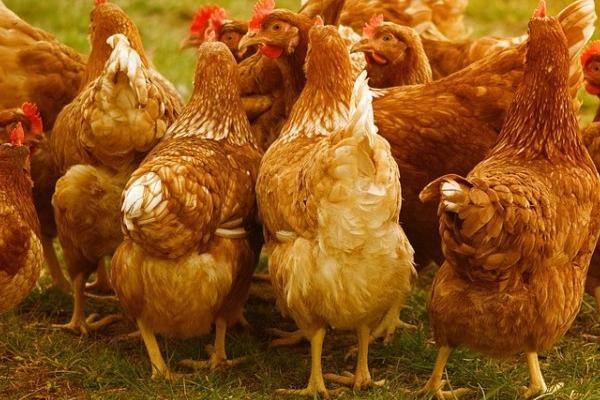
mahgoubら(2019)は、1~2 ml /kgのローズマリー冷圧エッセンシャルオイル(約3.5 g/kgのポリフェノールを含む)を食事に添加すると、性能、炭水化物の質、抗酸化能力が改善され、ウズラ中の有害なileal微生物の数が減少したことを発見した。ローズマリー精油(150,250 mg/kg)を食事に添加すると、熱ストレスを受けたウズラの精巣の脂質過酸化が減少し、組織損傷が軽減され、精子細胞数が増加し、アポトーシスが減少した(turk et al., 2016)。
Yang Jiansheng et al. (2016) showed that the addition of 0.3% rosemary herb powder to the diet of laying hens increased egg production rate and average daily total egg weight, improved egg yolk color, and increased serum albumin level. Adding 0.6% rosemary herb powder to the diet of laying hens significantly improved the antioxidant capacity and egg quality of eggs during the high temperature season (An Tingting et al., 2017) and reduced the expression of heat shock protein 70 (HSP70) gene in the ovary, uterus, heart, lungs, and kidneys, and increased the expression of lysozyme gene in the ovary, isthmus, heart, liver, spleen, lungs, small intestine, and adeno-gastric region, and alleviated the damage caused by heat stress on the performance of laying hens (Wang Xiaohui et al., 2017). damage of heat stress on the production performance of laying hens (Wang, Xiaohui et al., 2019).
4.2豚
ローズマリー精油(250 mg/kg)を食事に添加すると、離乳した子豚の1日平均摂取量が増加し、飼料重量比が低下し、粗タンパク質、カルシウム、リンの見かけ上の消化率が増加しました(li, fangfang et al., 2019)。ma hongら(2021)は、カプセル化されたローズマリー精油(300 mg/kg)を食事に添加すると、離乳子の飼料転換効率、粗脂肪と中性洗剤繊維の見かけの消化性、血清グルタチオンペルオキシダーゼの活性が増加することを発見した。liottaら(2015)は、豚の食事にローズマリー抽出物(1 g/kg)を添加すると、不飽和脂肪酸の含有量が増加し、豚の不飽和脂肪酸の含有量が改善することを発見した。malo et al.(2011)は、ローズマリー抽出物が凍結や解凍によるブタの精子の質への影響を防ぎ、精子の生存率を高め、脂質過酸化レベルを低下させることを示した。
反芻動物4.3
ローズマリージテルペン(シリマリニン酸およびシリビノール、600 mg/kg)を肉ヤギの餌に添加すると、肉に沈着し、肉の酸化や微生物数などが減少した(2015)。蒸留されたローズマリーの葉をewesの食事に添加すると、牛乳の収量と品質に悪影響を及ぼすことはなく、羊&でフラボノイド(例:ヘスペリジン、ナリンゲニン、コリアンダー)、ガ酸およびフェノールジテルペン(ラムノサス酸およびラムノル)の含有量が増加した#39;s milk, and polyphenolics such as rhamnolic acid, rhamnosus acid and rhamnol could be transferred to the plasma of young lambs (Jordán et al., 2010). Chiofalo et al. (2010) added rosemary extract (600, 1200 mg/head-d) to the diet of ewes and found that milk yield and milk levels of protein, casein, fat and lactose were higher in the high-dose group than in the low-dose group and the control group; the addition of rosemary extract decreased the curdling time and increased the hardness of curd.Boutoial et al. (2013) found that the addition of distilled peroxide to the diet of dairy goats resulted in the reduction of the curdling time and the increase of curd hardness. Boutoial et al. (2013) found that the addition of distilled rosemary (20%) to the diet of dairy goats reduced the curdling time, dry matter and lactose content of pasteurized milk; 10% addition decreased the percentage of C14 fatty acids and increased the levels of C18:2 and polyunsaturated fatty acids (PUFA), while 20% reduction in the levels of C10 and C14 increased the percentages of C17, C18:2 and PUFA; 20% addition significantly affected the protein content of cheese. The addition of rosemary to the diet significantly affected cheese protein content, pH and water activity. Addition of rosemary extract (2.14 g/kg) to the diet increased serum glutathione peroxidase (GSH-Px), immunoglobulin A (IgA) and immunoglobulin M (IgM) levels in dairy goats (Ziyang Zhang et al., 2021).
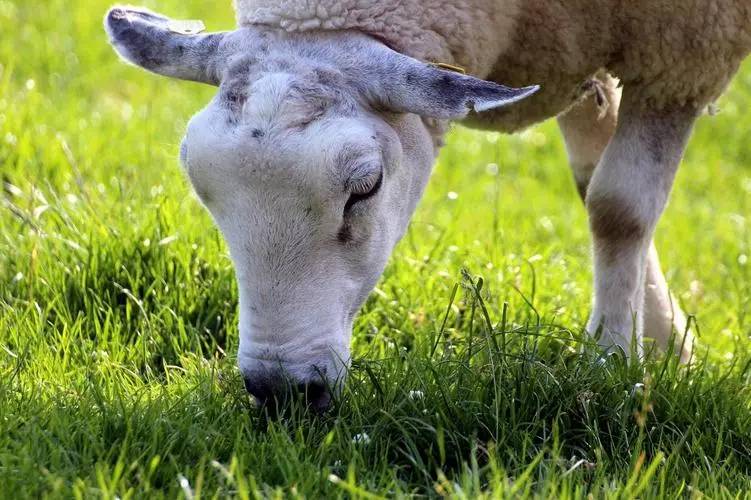
de oliveira monteschio(2017)は、ディエップの精油(4 g/head-d)の栄養補助食品を添加すると、牛肉の脂質酸化が減少し、肉の品質が向上し、ラック寿命が増加することを発見した。^ a b c d e e f g h i#39; grady et al.(2006)では、除草剤抽出物の1000 mg/head-dの栄養補助食品を牛肉の飼料に添加すると、肉の脂質安定性と肉の色が改善されることが明らかになった。
5概要
ローズマリーは、家畜や家禽のパフォーマンス、腸の健康、抗酸化状態と畜産物の品質を向上させることができる抗菌、抗炎症、抗酸化活性を持つテルペノイド、フラボノイド、有機酸が豊富です。動物の生産におけるローズマリーの適用効果は、サンプルの出所、生産プロセス、添加物の量などの要因によって影響されます。適切な製品規格の策定は、ローズマリーの評価と適用のために特に重要です。現在、家畜生産におけるローズマリーの研究は体系的ではありません。例えば、腸内の健康や抗酸化活性の分子メカニズムはまだ解明されていません。
参考:
[1] an tingting, xin shijie, dai guojun, et al。高温期における異なる保存時間における卵の品質とその抗酸化特性に対する食餌ローズマリー添加の影響[j]。楊州大学紀要:農業と生命科学編,2017,38(1):35 ~ 39。
【2】耿麗軍、趙樹娟。ローズマリン酸の生合成法に関する研究[j]。上海中医薬大学ジャーナル,2018,32(2):95 ~ 99。
[3]何黎偉、傅晨清、姚山ほかローズマリー抽出物の活性成分とその薬理作用の簡単な説明[j]。農業科学浙江で、61(10日):"、2020 2068 ~ 2073。
【4】李愛華。静海黄鶏の肉の性能、肉の品質および一部の盲目の腸の微生物に対するローズマリー抽出物の影響[d]。2014年揚州大学。
[5] li fangfang, yang jingjing, zhang ruiyang, et al。乳離れ子豚の成長性能、血清生化学指標および栄養見かけの除去率に対するエッセンシャルオイルの影響[j]。動物栄養学会誌,2019,31(3):1428 ~ 1433。
[6] liu dalin, wang kui, yang junxiu, et al。金海黄鶏の成長性能、肉質、抗酸化指数に対するジペパ精油の影響に関する研究[j]。中国畜産学会誌,2014,50(11):65 ~ 68。
[7] liu shengnan, ma yunfang, fan liumin, et al。ローズマリーの活性成分と生理機能に関する研究[j]。農産物加工、2019、13:79 ~ 83。
[8] liu yanan, li aihua, xie kaizhou, et al。ローズマリー抽出物の静海黄鶏の成長性能、免疫器官指数、血清抗酸化活性に対する効果[j]。 中国獣医学会誌,2016,36(7):1218 ~ 1223,1272。
[9] ma hong, ma jiayu, long shenfei, et al。ローズマリー精油の成長性能への影響,栄養素の明らかな消化率,血清免疫と抗酸化指標離乳子豚の[j]。栄养の日刊動物が良く、2021年33(12):6740 ~ 6748。
[10] pan yan, bai hongtong, li hui, et al。ローズマリーの精油組成と抗菌活性に対する栽培地、収穫時期、植物齢の影響[j]。the journal of botany, 2013, 47(6): 625 ~ 636。
【11】任麗萍、李賢甲、金少柱。ローズマリー葉の全フラボノイドと抗酸化活性の分離・精製[j]。^「china flavorings, 2017, 42(4): 69 ~ 73。
【12】蔡春美、梁小媛。ローズマリーに関する薬理学的研究[j]。^『仙台市史』仙台市史編纂委員会、2012年(平成24年)、65 - 66頁。
[13] wang xiaohui, xin shijie, zou wenbin, et al。高温下における飼育鶏のさまざまな組織におけるhsp70およびlyz遺伝子の発現に対するローズマリーの栄養補給およびビタミンe、ビタミンcおよび大豆油の組み合わせの影響[j]。中国獣医学会誌,2019,39(4):767 ~ 773。
【14】王燕。ロスマリン酸の生物学的機能と畜産への応用の展望[j]。^ a b c d e f g h i(2013年)、22 - 31頁。
【15】呉孟、徐暁軍。ローズマリーの化学組成と薬理作用に関する最近の研究成果[j]。バイオマス化学工学,2016,50(3):51 ~ 57。
[16] yang jiansheng, lin yuxin, an tingting, et al。ローズマリーバニラパウダーの産卵性能,高温鶏卵の品質と血清指数に対する影響[j]。中国飼料、2016、19:9 ~ 11:25。
[17] zhang lin, yang su lin, zhang guoliang, et al。ジベリン酸の抽出・分離・精製プロセスに関する研究[j]。guangzhou chemical industry, 2016, 44(19): 105 ~ 107。
乳ヤギの生産性、抗酸化能力、免疫機能に対するローズマリー抽出物の飼料添加の効果[j]。^ a b c d e f g h i『官報』第2033号、大正7年(1875年)10月23日。
[19] zhao xueli, wu huihui, zhao zhengshan, et al。ローズマリーの抽出プロセスと食品への応用[j]。穀物や原油、2020年、33(3):31 ~ 33。
[20] shen tingting, chen wen, zhao jiang, et al。高脂肪食ハムスターにおけるローズマリー抽出物によるnrf2および下流の抗酸化遺伝子の調節[j]。journal of nutrition, 2014, 36(5):475~480。
[21] beretta g, artali r, facino r m, et al。エッセン-シャル油の抗酸化活性のプロファイリングのための分析とtheo- reticalアプローチ:rosmarinus officinalis lのケース[j]。j pharm biomed, anal, 2011, 55(5):1255 ~ 1264。
[22] boutoial k, ferrandini e rovira s, et al。)によってローズマリーとヤギを供給する効果(rosmarinus officinalis spp.) -ミルクとチーズの特性上の製品[j]。small rumin res, 2012, 112(1 ~ 3):147 ~ 153。
[23] chiofalo b, riolo e b, fasciana g, et al。乳羊における栄養ローズマリー抽出物の有機管理:牛乳の品質と凝固特性への影響[j]。^ a b c d e f g h i(2010年)、134頁。
[24] de macedo l m, santos m d, milit o l, et al。ローズマリー
(rosmarinus officinalis l ., syn salvia rosmarinus spenn .)とそのトップicalアプリケーション:レビュー[j]。^ a b c d e f『人事興信録』第9版、651 - 662頁。
[25] de oliveira monteschio j, de souza k a, vital a c p, et al。クローブとローズマリーのエッセンシャルオイルと、フィードロット仕上げのハイファーの肉の品質に関するカプセル化活性原理(eugenol、thymol、vanillinブレンド)[j]。肉sci, 2017, 130: 50 ~ 57。
[26] ghazalah a a、ali a m .ローズマリーはブロイラー鶏の成長のための栄養補助食品として葉[j]。international j poult sci, 2008, 7(3): 234 ~ 239。
[27]ハンソンj r .ローズマリー,庭のハーブの有益な化学[j]。sci prog, 2016, 99(1): 83 ~ 91。
[28] jiang y, wu n, fu y j, et al。ローズマリー精油の化学組成と抗i- crobial活性[j]。』講談社、2011年。32(1面)63 ~ 68。
[29] jordan m j, moino m i, martinez c, et al。disの導入- murciano - granadinaヤギの食事にローズマリーの葉をtillate:ヤギへのポリフェノール化合物の転送'ヤギの子ヤギのミルクとプラズマ[j]。j agric food chem, 2010, 58(14):8265 ~ 8270。
[30] kompelly a, kompelly s, vasudha b, et al。rosmarinus offici- nalis l .:その植物化学的および生物学的活性の更新レビュー- ty [j]。j drug deliv, 2019, 9(1):323 ~ 330。
[31] kuo c f, su j d, chiu c h, et al。rosmarinus officinalisの葉からの超臨界二酸化炭素抽出物および単離されたカルノシン酸の抗炎症作用[j]。j agric food chem, 2011, 59(8): 3674 ~ 3685。
[32] lemos m f, lemos m f, pacheco h p, et al。季節モディ- fies rosemary'の組成および生物学的活性[j]。2015年を守ろうとする構想作物差し込もうとするまで、70:41 ~ 47。
[33] liotta l, chiofalo v, d ' alessandro e, et al。nero siciliano豚の食事中のローズマリー抽出物の補充:肉の品質に対する抗酸化特性の評価[j]。2005年(平成17年):1065 - 1072。
[34] luqman s, dwivedi g r, darokar m p, et al。薬剤耐性感染症に使用されるローズメアリー油の可能性[j]。2007年Altern人数健康医学13(5):54 ~ 59。
[35] mahgoub s a m, el-hack m e a, saadeldin i m, et al。冷間圧搾油rosmarinus officinalisの健康、生育環境、腸内細菌数、ウズラの免疫力への影響[j]。^ a b c d e f g h i, 2019, 98(5): 2139 ~ 2149。
[36] malo c, gil l, cano r, et al。冷凍保存中のイノシシの上体精子に対するローズマリー(rosmarinus officinalis)の抗酸化作用。2011年Theriogenology、1741年)75(9):1735年~死去。
[37] mathlouthi n, bouzaienne t, oueslati i, et al。ブロイラー鶏におけるローズマリー、オレガノ、およびエッセンシャルオイルの商業的ブレンドの使用:in vitro antimicrobial activities and effects on growth performance[j]。 j anim sci, 2011, 90(3): 813 ~ 823。
[38] O' grady m n, maher m, troy d j, et al。an assessment of etary supplementation with tea catechins and rosemary extract on the quality of fresh beef[j]. meat sci, 2006, 73(1):132 ~ 143。
[39] okamura n, fujimoto y, kuwabara s, et al。rosmarinus officinalisおよびsalvia officinalisにおけるカルノシン酸およびカルノゾールの高性能液体クロマトグラフィー測定[j]。^ a b c d e f g h i j chromatogr a, 1994, 679(2): 381 ~ 386。
[40] ortuoj, serrano r, baon s, et al。抗酸化と抗菌-保護的な雰囲気を詰めラム肉にローズマリーのジテルペン(カルノシン酸とカルノゾール)対ビタミンeを使用した栄養補助食品の副作用[j]。2015年肉Sci、110:62 ~ 69。
[41] peng y, yuan j, liu f, et al。電気化学的検出を用いたキャピラリー電気泳動によるローズマリー中の活性コンポネントの測定[j]。2005年Pharmaceut出来る、39(3 ~ 4):431 ~ 437。
[42] rakovi a, milanovi i, pavlovi n, et al。ローズマリー(rosmarinus officinalis l .)精油とそのhepatoprotec- tive電位の抗酸化活性[j]。^ a b c d e『仙台市史』、仙台市、2014年、14 - 25頁。
[43] bi liangwu, zhao zhendong, et al。european dieppeの研究状況[j]。バイオマス化学工学,2006,40(2):41-44。
[44] rostami h, seidavi a, dadashbeiki m, et al。サプリメントdi-ブロイラー鶏の体内ローズマリー(rosmarinus officinalis l .)パウダーとビタミンe:体液性免疫応答、リンパ器官、および血液タンパク質の評価[j]。必要ないSci Res PollutいIntで、25(2):、2018年1 ~ 7 .
[45] satyal p, jones t h, lopez e m, et al。rosmarinus officinalisの化学的特徴と生物学的活性[j]。2017年(平成29年)3月20日- 3号機が完成。
[46] swamy m k, akhtar m s, sinniah u r . antimicrobial proper- ties of plant essential oil against human pathogens and their action mode: an updated review[j]。^『週刊ファミ通』2016年1月号、21 - 21頁。
[47] tadtong s, kamkaen n, watthanachaiyingcharoen r, et al。アロマテラピーにおける4つの必須オールの化学成分[j]。nat prod commun, 2015, 10(6):1091 ~ 1092。
[48] tang s, yin b, xu j, et al。ローズマリーは、ブロイラーニワトリのcryabとhsp70の発現を抑制することで、熱ストレスを軽減する[j]。』岩波書店、2018年。2018:7014126。
[49] turk g, c,eriba a o, s, imek u g, et al。食事中のローズマリー油は、生育中のウズラの精巣内の脂質過酸化を介して、熱ストレスによる構造的および機能的損傷を緩和する[j]。2016年Anim Reprod Sci 164(14): 133 ~ 143から構成される。
[50] wang w, li n, luo m, et al。rosmarinus offificinalis l .精油の抗菌活性と抗がん活性を主成分と比較[j]。分子,2012,17(3):2704 ~ 2713。[51] yesilbag d, eren m, agel h, et al。e食事ローズマリーのects,ブロイラー性能上のローズマリー揮発性オイルとビタミンe,肉の品質と血清sod活性[j]。2011年イギリスPoult Sci、52(4):472 ~ 482。
[52] zanella c a, treichel h, cansian r l, et al。ローズマリーのハイドロアルコール抽出物の急性投与の効果(rosmarinus officinalis l .)(lamiaceae) in animal models of memory[j]。brazilian j pharm sci, 2012, 48(3): 389 ~ 397。
[53] zeng h h, tu p f, zhou k, et al。rosmarinus officinalisからのフェノールジテルペンの抗酸化特性[j]。acta pharmacol sin, 2001, 22(12):1094 ~ 1098。
[54]鄭w、王s y .抗酸化活性とフェノールcom-選択されたハーブでポンド[j]。j agric food chem, 2001, 49(11):5165 ~ 5170。
-
Prev
Advanced Liposomal CoQ10 by Green Spring Technology: Elevating Cosmetic Performance
-
次
食品用ローズマリー抽出物の応用


 英語
英語 フランス
フランス スペイン
スペイン ロシア
ロシア 韓国
韓国 日本
日本